Sustainable Design 2: Product Service Systems Backcasting Report
VerifiedAdded on 2022/08/20
|16
|2555
|21
Report
AI Summary
This report analyzes a sustainable energy solution for the protection of banana fruit during the shipping process. The student explores the problem of damaged bananas due to insufficient refrigeration, leading to significant waste. The report proposes a solar-powered refrigerator carrier as a sustainable solution, aiming to maintain constant cooling temperatures and reduce carbon emissions. It includes a literature review, methodology (brainstorming, design space exploration, and design checklist), and implementation details. The report evaluates the effectiveness of the solar-powered system, discusses ethical constraints and implementation challenges, and concludes with a summary of the benefits of the proposed solution, emphasizing environmental sustainability and enhanced living standards. It also includes SWOT analysis and system stakeholder maps.
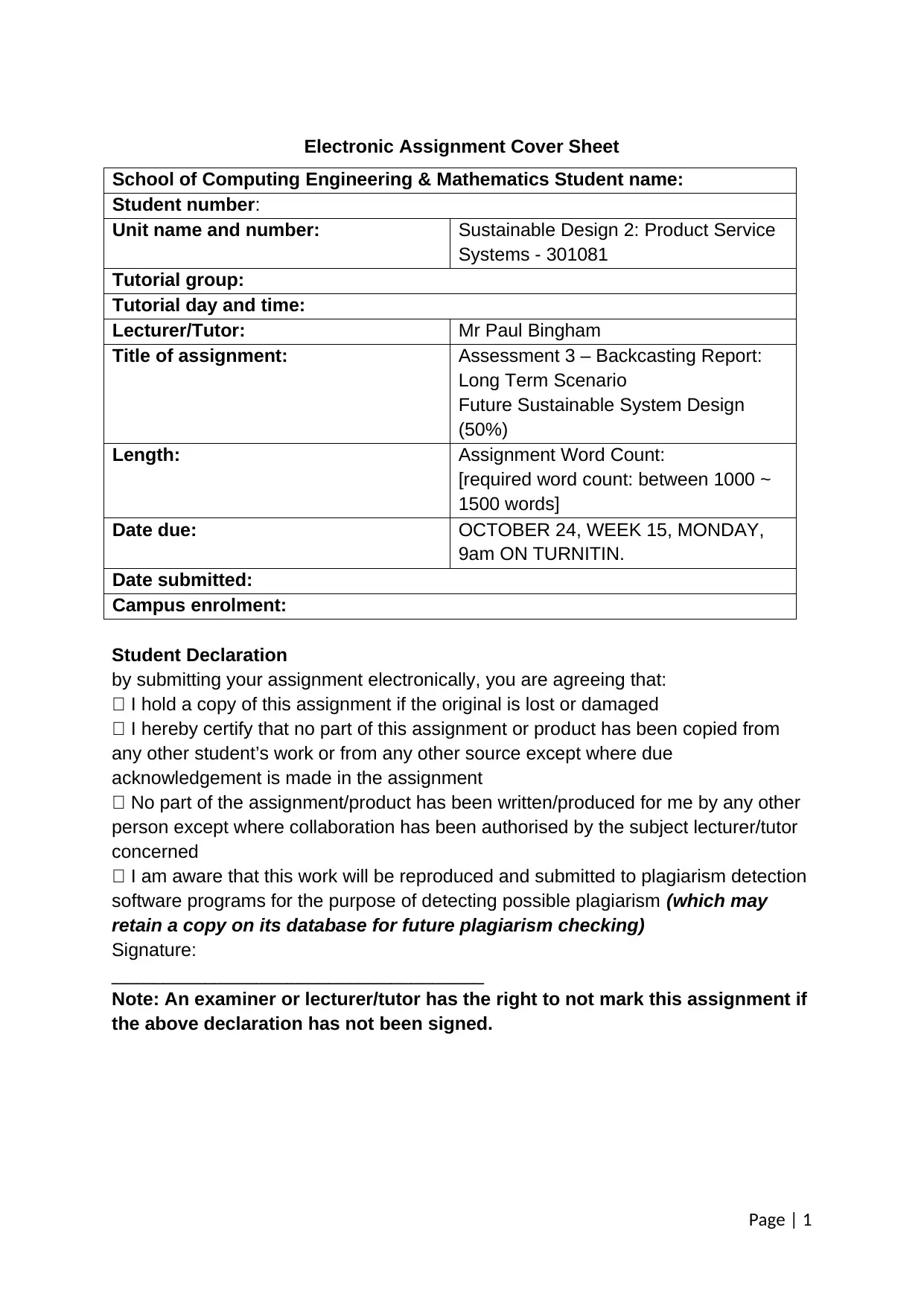
Electronic Assignment Cover Sheet
School of Computing Engineering & Mathematics Student name:
Student number:
Unit name and number: Sustainable Design 2: Product Service
Systems - 301081
Tutorial group:
Tutorial day and time:
Lecturer/Tutor: Mr Paul Bingham
Title of assignment: Assessment 3 – Backcasting Report:
Long Term Scenario
Future Sustainable System Design
(50%)
Length: Assignment Word Count:
[required word count: between 1000 ~
1500 words]
Date due: OCTOBER 24, WEEK 15, MONDAY,
9am ON TURNITIN.
Date submitted:
Campus enrolment:
Student Declaration
by submitting your assignment electronically, you are agreeing that:
I hold a copy of this assignment if the original is lost or damaged
I hereby certify that no part of this assignment or product has been copied from
any other student’s work or from any other source except where due
acknowledgement is made in the assignment
No part of the assignment/product has been written/produced for me by any other
person except where collaboration has been authorised by the subject lecturer/tutor
concerned
I am aware that this work will be reproduced and submitted to plagiarism detection
software programs for the purpose of detecting possible plagiarism (which may
retain a copy on its database for future plagiarism checking)
Signature:
____________________________________
Note: An examiner or lecturer/tutor has the right to not mark this assignment if
the above declaration has not been signed.
Page | 1
School of Computing Engineering & Mathematics Student name:
Student number:
Unit name and number: Sustainable Design 2: Product Service
Systems - 301081
Tutorial group:
Tutorial day and time:
Lecturer/Tutor: Mr Paul Bingham
Title of assignment: Assessment 3 – Backcasting Report:
Long Term Scenario
Future Sustainable System Design
(50%)
Length: Assignment Word Count:
[required word count: between 1000 ~
1500 words]
Date due: OCTOBER 24, WEEK 15, MONDAY,
9am ON TURNITIN.
Date submitted:
Campus enrolment:
Student Declaration
by submitting your assignment electronically, you are agreeing that:
I hold a copy of this assignment if the original is lost or damaged
I hereby certify that no part of this assignment or product has been copied from
any other student’s work or from any other source except where due
acknowledgement is made in the assignment
No part of the assignment/product has been written/produced for me by any other
person except where collaboration has been authorised by the subject lecturer/tutor
concerned
I am aware that this work will be reproduced and submitted to plagiarism detection
software programs for the purpose of detecting possible plagiarism (which may
retain a copy on its database for future plagiarism checking)
Signature:
____________________________________
Note: An examiner or lecturer/tutor has the right to not mark this assignment if
the above declaration has not been signed.
Page | 1
Paraphrase This Document
Need a fresh take? Get an instant paraphrase of this document with our AI Paraphraser
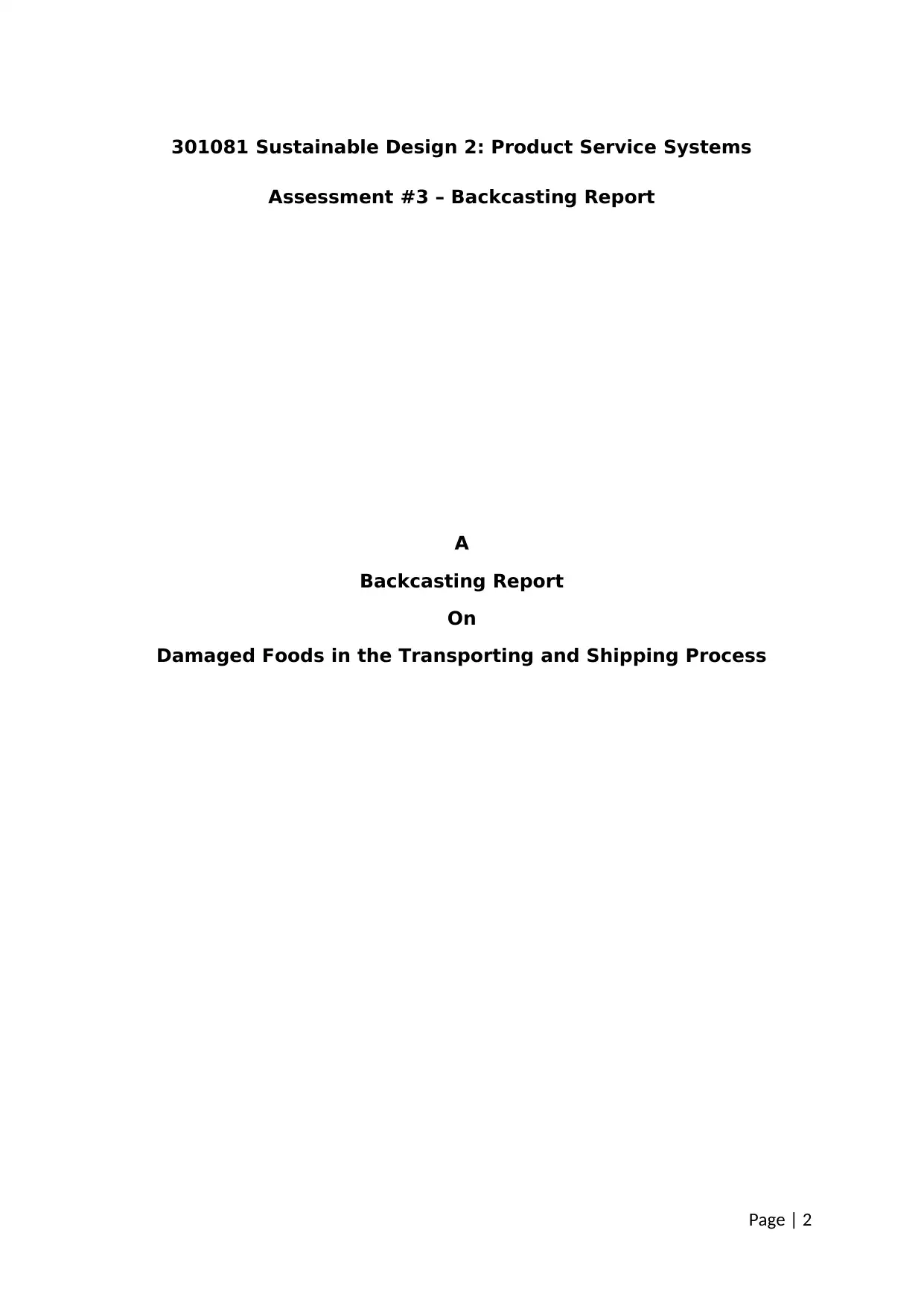
301081 Sustainable Design 2: Product Service Systems
Assessment #3 – Backcasting Report
A
Backcasting Report
On
Damaged Foods in the Transporting and Shipping Process
Page | 2
Assessment #3 – Backcasting Report
A
Backcasting Report
On
Damaged Foods in the Transporting and Shipping Process
Page | 2
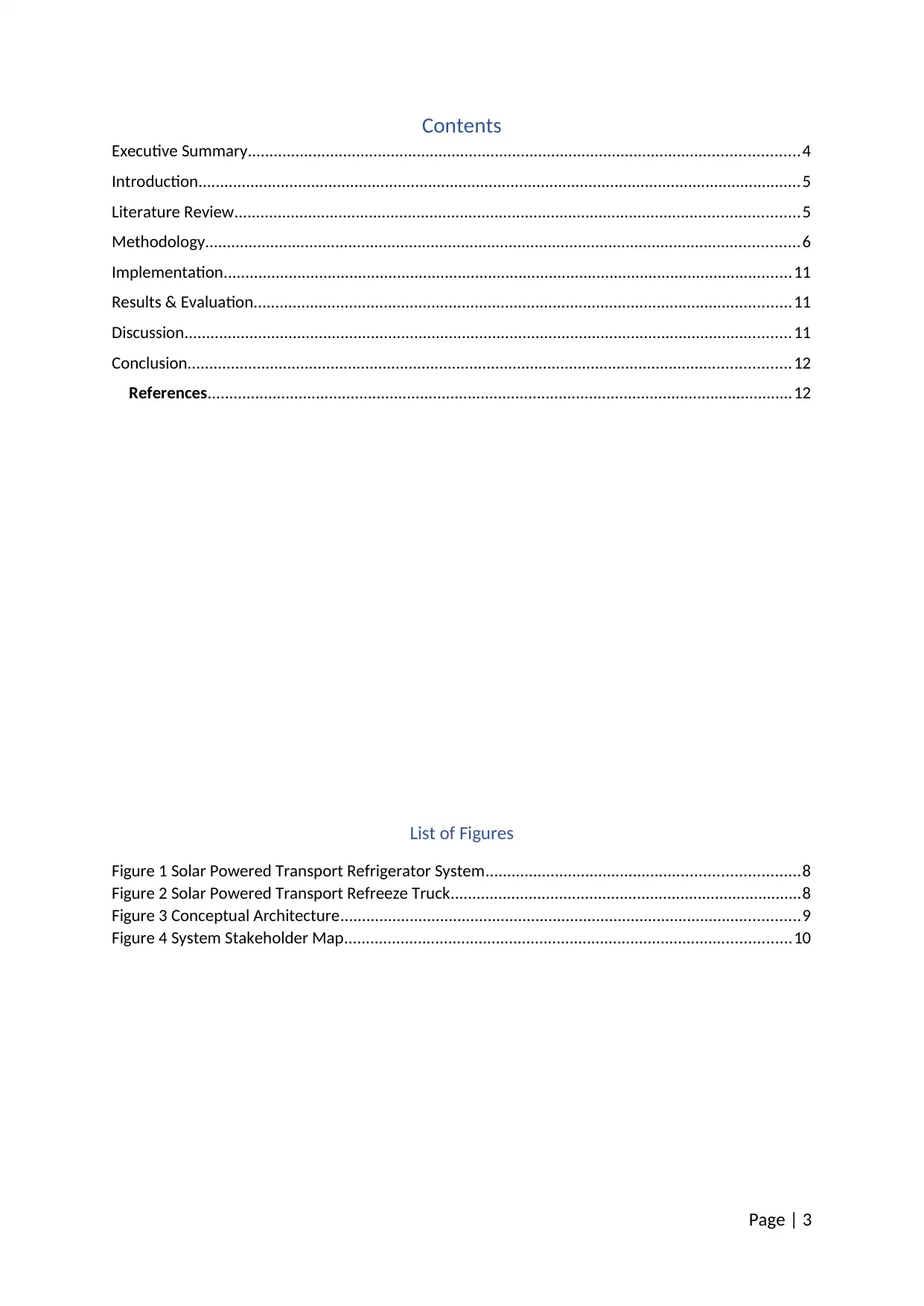
Contents
Executive Summary...............................................................................................................................4
Introduction...........................................................................................................................................5
Literature Review..................................................................................................................................5
Methodology.........................................................................................................................................6
Implementation...................................................................................................................................11
Results & Evaluation............................................................................................................................11
Discussion............................................................................................................................................11
Conclusion...........................................................................................................................................12
References.......................................................................................................................................12
List of Figures
Figure 1 Solar Powered Transport Refrigerator System........................................................................8
Figure 2 Solar Powered Transport Refreeze Truck.................................................................................8
Figure 3 Conceptual Architecture..........................................................................................................9
Figure 4 System Stakeholder Map.......................................................................................................10
Page | 3
Executive Summary...............................................................................................................................4
Introduction...........................................................................................................................................5
Literature Review..................................................................................................................................5
Methodology.........................................................................................................................................6
Implementation...................................................................................................................................11
Results & Evaluation............................................................................................................................11
Discussion............................................................................................................................................11
Conclusion...........................................................................................................................................12
References.......................................................................................................................................12
List of Figures
Figure 1 Solar Powered Transport Refrigerator System........................................................................8
Figure 2 Solar Powered Transport Refreeze Truck.................................................................................8
Figure 3 Conceptual Architecture..........................................................................................................9
Figure 4 System Stakeholder Map.......................................................................................................10
Page | 3
⊘ This is a preview!⊘
Do you want full access?
Subscribe today to unlock all pages.

Trusted by 1+ million students worldwide
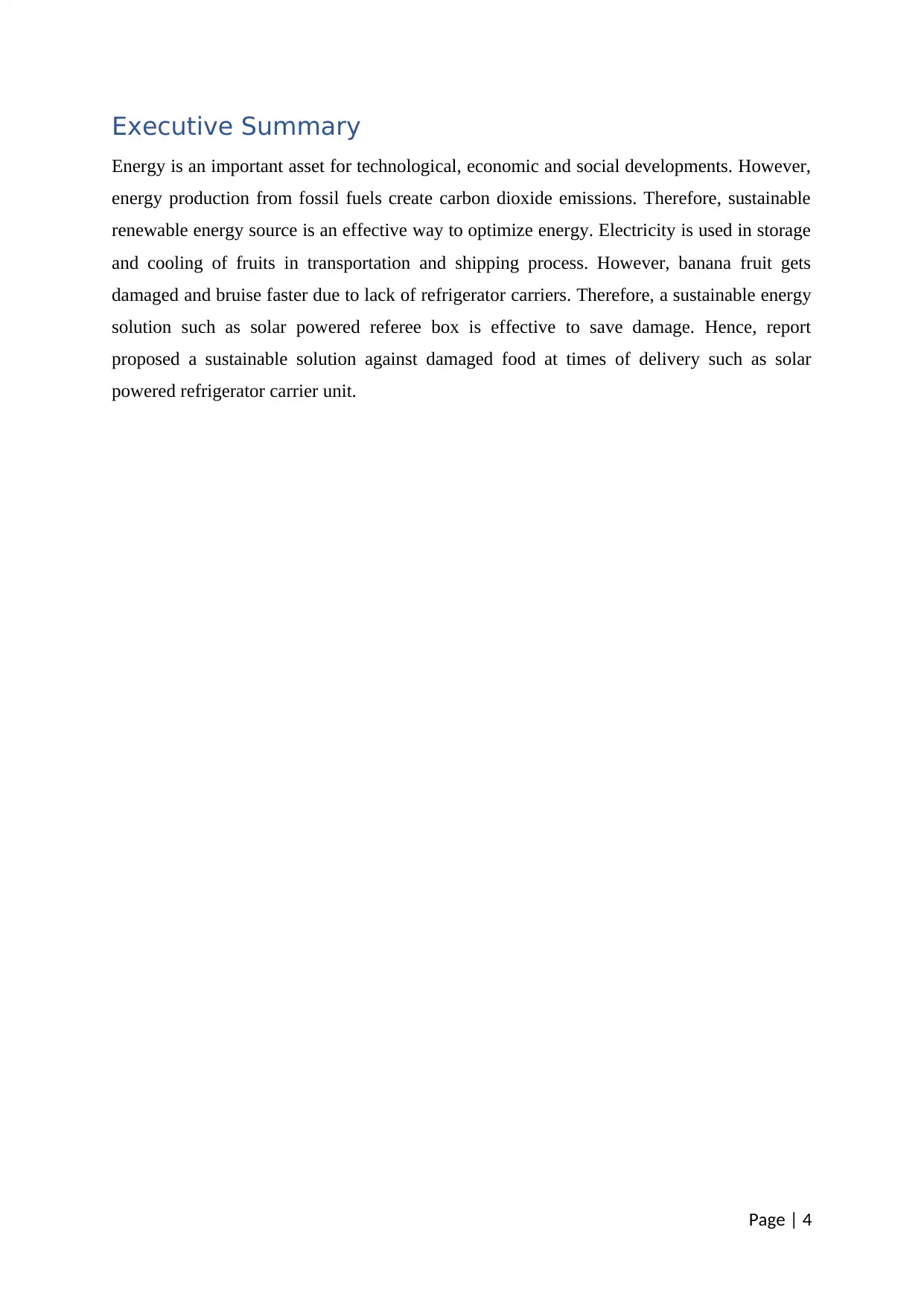
Executive Summary
Energy is an important asset for technological, economic and social developments. However,
energy production from fossil fuels create carbon dioxide emissions. Therefore, sustainable
renewable energy source is an effective way to optimize energy. Electricity is used in storage
and cooling of fruits in transportation and shipping process. However, banana fruit gets
damaged and bruise faster due to lack of refrigerator carriers. Therefore, a sustainable energy
solution such as solar powered referee box is effective to save damage. Hence, report
proposed a sustainable solution against damaged food at times of delivery such as solar
powered refrigerator carrier unit.
Page | 4
Energy is an important asset for technological, economic and social developments. However,
energy production from fossil fuels create carbon dioxide emissions. Therefore, sustainable
renewable energy source is an effective way to optimize energy. Electricity is used in storage
and cooling of fruits in transportation and shipping process. However, banana fruit gets
damaged and bruise faster due to lack of refrigerator carriers. Therefore, a sustainable energy
solution such as solar powered referee box is effective to save damage. Hence, report
proposed a sustainable solution against damaged food at times of delivery such as solar
powered refrigerator carrier unit.
Page | 4
Paraphrase This Document
Need a fresh take? Get an instant paraphrase of this document with our AI Paraphraser
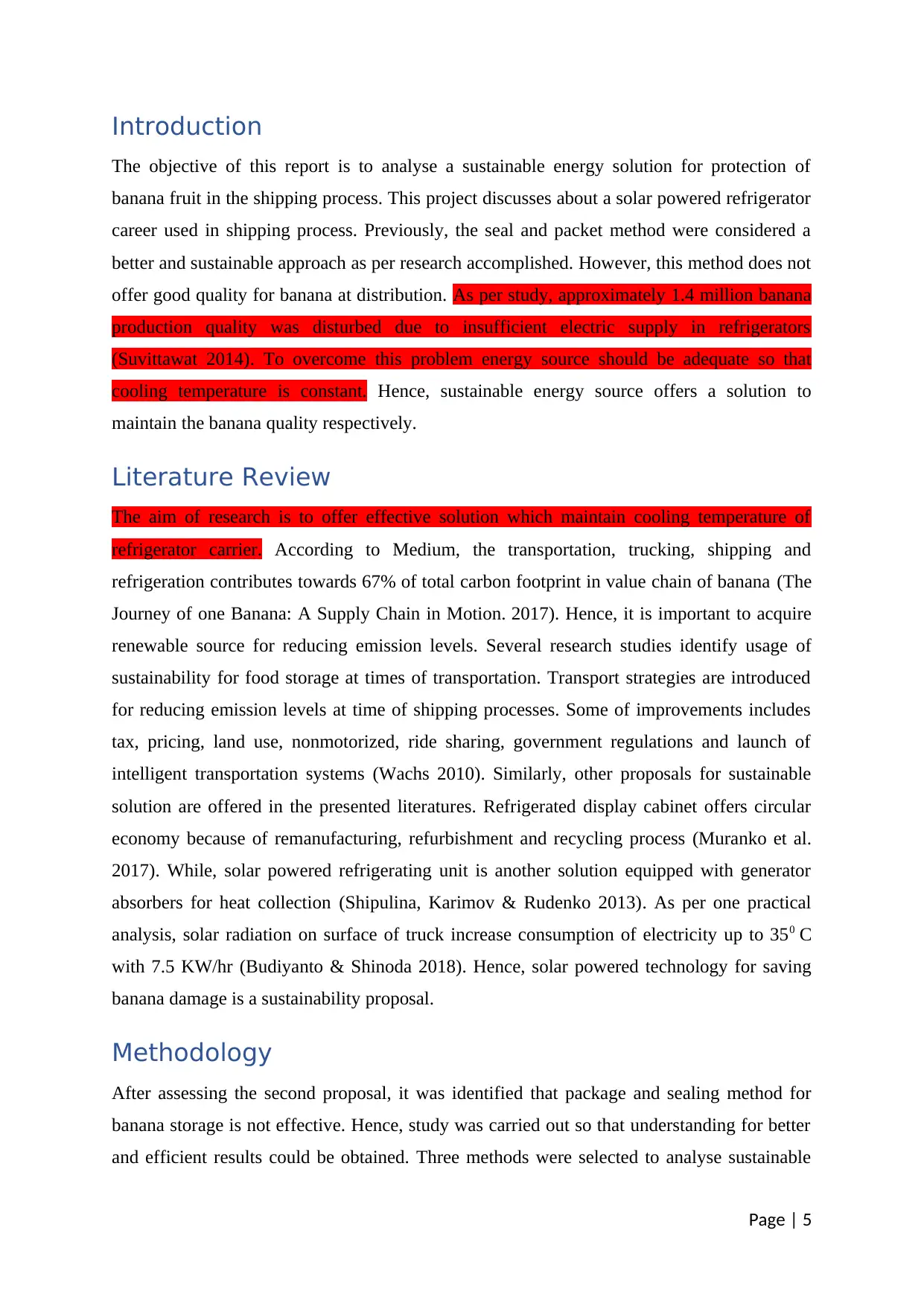
Introduction
The objective of this report is to analyse a sustainable energy solution for protection of
banana fruit in the shipping process. This project discusses about a solar powered refrigerator
career used in shipping process. Previously, the seal and packet method were considered a
better and sustainable approach as per research accomplished. However, this method does not
offer good quality for banana at distribution. As per study, approximately 1.4 million banana
production quality was disturbed due to insufficient electric supply in refrigerators
(Suvittawat 2014). To overcome this problem energy source should be adequate so that
cooling temperature is constant. Hence, sustainable energy source offers a solution to
maintain the banana quality respectively.
Literature Review
The aim of research is to offer effective solution which maintain cooling temperature of
refrigerator carrier. According to Medium, the transportation, trucking, shipping and
refrigeration contributes towards 67% of total carbon footprint in value chain of banana (The
Journey of one Banana: A Supply Chain in Motion. 2017). Hence, it is important to acquire
renewable source for reducing emission levels. Several research studies identify usage of
sustainability for food storage at times of transportation. Transport strategies are introduced
for reducing emission levels at time of shipping processes. Some of improvements includes
tax, pricing, land use, nonmotorized, ride sharing, government regulations and launch of
intelligent transportation systems (Wachs 2010). Similarly, other proposals for sustainable
solution are offered in the presented literatures. Refrigerated display cabinet offers circular
economy because of remanufacturing, refurbishment and recycling process (Muranko et al.
2017). While, solar powered refrigerating unit is another solution equipped with generator
absorbers for heat collection (Shipulina, Karimov & Rudenko 2013). As per one practical
analysis, solar radiation on surface of truck increase consumption of electricity up to 350 C
with 7.5 KW/hr (Budiyanto & Shinoda 2018). Hence, solar powered technology for saving
banana damage is a sustainability proposal.
Methodology
After assessing the second proposal, it was identified that package and sealing method for
banana storage is not effective. Hence, study was carried out so that understanding for better
and efficient results could be obtained. Three methods were selected to analyse sustainable
Page | 5
The objective of this report is to analyse a sustainable energy solution for protection of
banana fruit in the shipping process. This project discusses about a solar powered refrigerator
career used in shipping process. Previously, the seal and packet method were considered a
better and sustainable approach as per research accomplished. However, this method does not
offer good quality for banana at distribution. As per study, approximately 1.4 million banana
production quality was disturbed due to insufficient electric supply in refrigerators
(Suvittawat 2014). To overcome this problem energy source should be adequate so that
cooling temperature is constant. Hence, sustainable energy source offers a solution to
maintain the banana quality respectively.
Literature Review
The aim of research is to offer effective solution which maintain cooling temperature of
refrigerator carrier. According to Medium, the transportation, trucking, shipping and
refrigeration contributes towards 67% of total carbon footprint in value chain of banana (The
Journey of one Banana: A Supply Chain in Motion. 2017). Hence, it is important to acquire
renewable source for reducing emission levels. Several research studies identify usage of
sustainability for food storage at times of transportation. Transport strategies are introduced
for reducing emission levels at time of shipping processes. Some of improvements includes
tax, pricing, land use, nonmotorized, ride sharing, government regulations and launch of
intelligent transportation systems (Wachs 2010). Similarly, other proposals for sustainable
solution are offered in the presented literatures. Refrigerated display cabinet offers circular
economy because of remanufacturing, refurbishment and recycling process (Muranko et al.
2017). While, solar powered refrigerating unit is another solution equipped with generator
absorbers for heat collection (Shipulina, Karimov & Rudenko 2013). As per one practical
analysis, solar radiation on surface of truck increase consumption of electricity up to 350 C
with 7.5 KW/hr (Budiyanto & Shinoda 2018). Hence, solar powered technology for saving
banana damage is a sustainability proposal.
Methodology
After assessing the second proposal, it was identified that package and sealing method for
banana storage is not effective. Hence, study was carried out so that understanding for better
and efficient results could be obtained. Three methods were selected to analyse sustainable
Page | 5
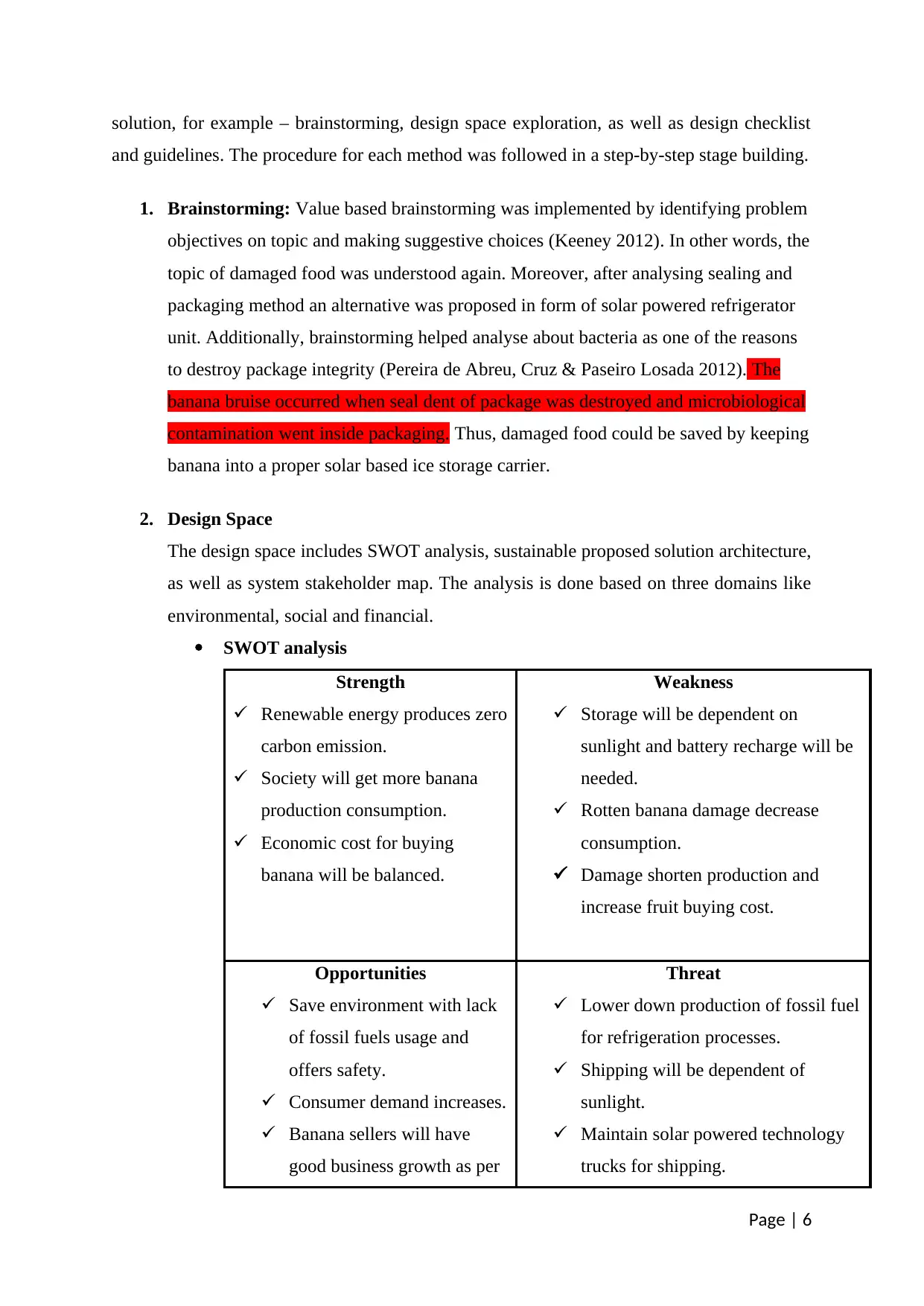
solution, for example – brainstorming, design space exploration, as well as design checklist
and guidelines. The procedure for each method was followed in a step-by-step stage building.
1. Brainstorming: Value based brainstorming was implemented by identifying problem
objectives on topic and making suggestive choices (Keeney 2012). In other words, the
topic of damaged food was understood again. Moreover, after analysing sealing and
packaging method an alternative was proposed in form of solar powered refrigerator
unit. Additionally, brainstorming helped analyse about bacteria as one of the reasons
to destroy package integrity (Pereira de Abreu, Cruz & Paseiro Losada 2012). The
banana bruise occurred when seal dent of package was destroyed and microbiological
contamination went inside packaging. Thus, damaged food could be saved by keeping
banana into a proper solar based ice storage carrier.
2. Design Space
The design space includes SWOT analysis, sustainable proposed solution architecture,
as well as system stakeholder map. The analysis is done based on three domains like
environmental, social and financial.
SWOT analysis
Strength
Renewable energy produces zero
carbon emission.
Society will get more banana
production consumption.
Economic cost for buying
banana will be balanced.
Weakness
Storage will be dependent on
sunlight and battery recharge will be
needed.
Rotten banana damage decrease
consumption.
Damage shorten production and
increase fruit buying cost.
Opportunities
Save environment with lack
of fossil fuels usage and
offers safety.
Consumer demand increases.
Banana sellers will have
good business growth as per
Threat
Lower down production of fossil fuel
for refrigeration processes.
Shipping will be dependent of
sunlight.
Maintain solar powered technology
trucks for shipping.
Page | 6
and guidelines. The procedure for each method was followed in a step-by-step stage building.
1. Brainstorming: Value based brainstorming was implemented by identifying problem
objectives on topic and making suggestive choices (Keeney 2012). In other words, the
topic of damaged food was understood again. Moreover, after analysing sealing and
packaging method an alternative was proposed in form of solar powered refrigerator
unit. Additionally, brainstorming helped analyse about bacteria as one of the reasons
to destroy package integrity (Pereira de Abreu, Cruz & Paseiro Losada 2012). The
banana bruise occurred when seal dent of package was destroyed and microbiological
contamination went inside packaging. Thus, damaged food could be saved by keeping
banana into a proper solar based ice storage carrier.
2. Design Space
The design space includes SWOT analysis, sustainable proposed solution architecture,
as well as system stakeholder map. The analysis is done based on three domains like
environmental, social and financial.
SWOT analysis
Strength
Renewable energy produces zero
carbon emission.
Society will get more banana
production consumption.
Economic cost for buying
banana will be balanced.
Weakness
Storage will be dependent on
sunlight and battery recharge will be
needed.
Rotten banana damage decrease
consumption.
Damage shorten production and
increase fruit buying cost.
Opportunities
Save environment with lack
of fossil fuels usage and
offers safety.
Consumer demand increases.
Banana sellers will have
good business growth as per
Threat
Lower down production of fossil fuel
for refrigeration processes.
Shipping will be dependent of
sunlight.
Maintain solar powered technology
trucks for shipping.
Page | 6
⊘ This is a preview!⊘
Do you want full access?
Subscribe today to unlock all pages.

Trusted by 1+ million students worldwide
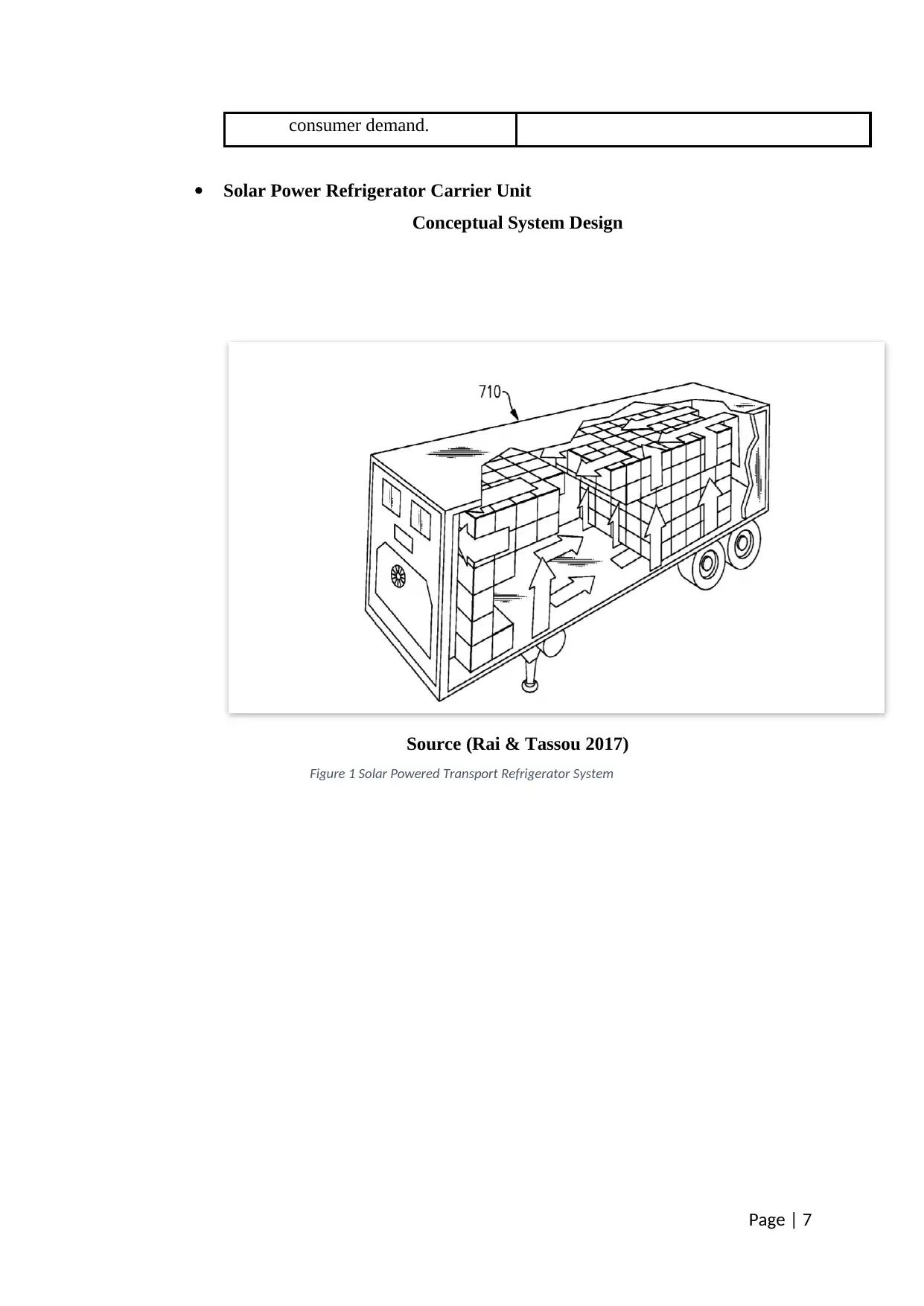
consumer demand.
Solar Power Refrigerator Carrier Unit
Conceptual System Design
Source (Rai & Tassou 2017)
Figure 1 Solar Powered Transport Refrigerator System
Page | 7
Solar Power Refrigerator Carrier Unit
Conceptual System Design
Source (Rai & Tassou 2017)
Figure 1 Solar Powered Transport Refrigerator System
Page | 7
Paraphrase This Document
Need a fresh take? Get an instant paraphrase of this document with our AI Paraphraser
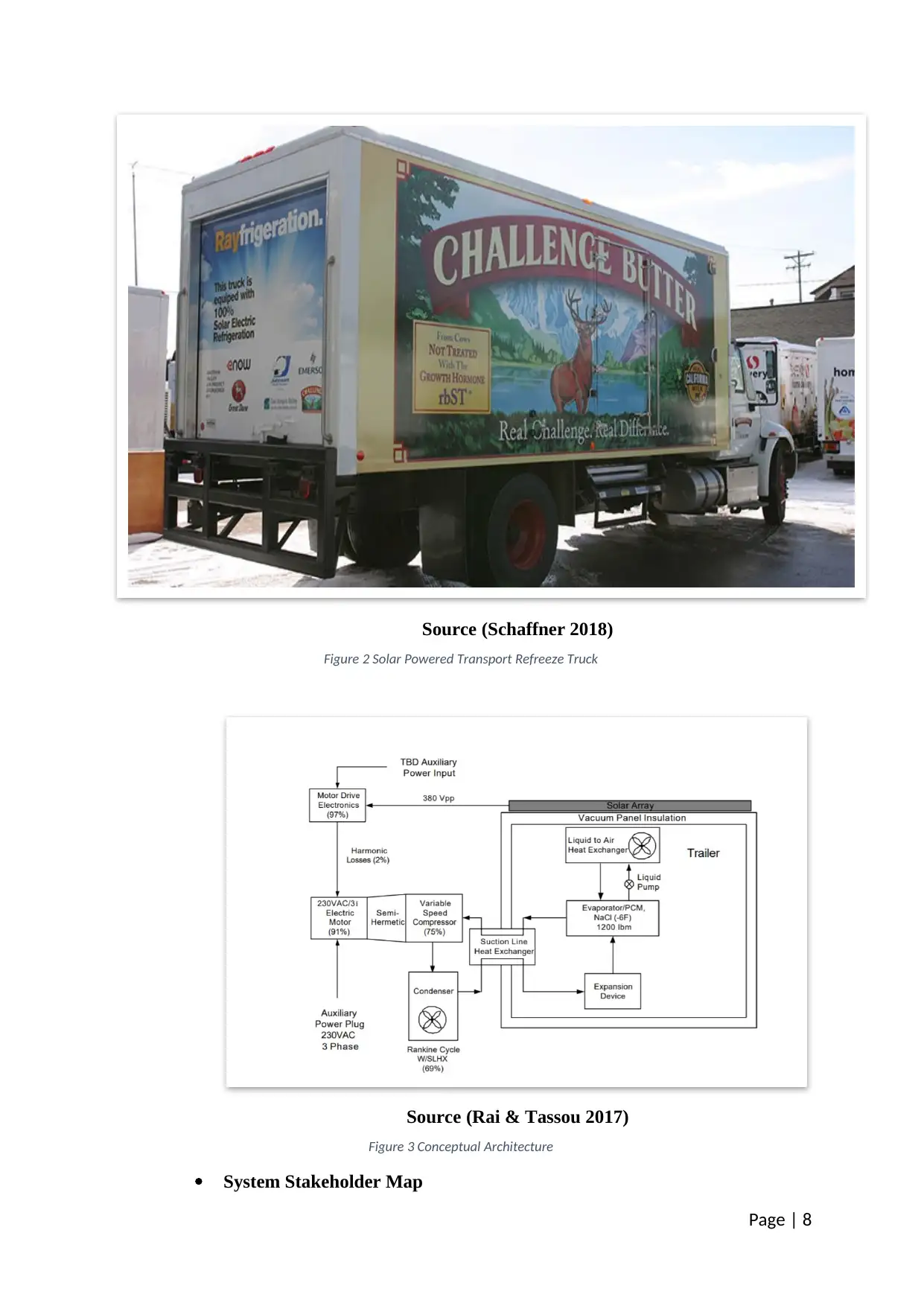
Source (Schaffner 2018)
Figure 2 Solar Powered Transport Refreeze Truck
Source (Rai & Tassou 2017)
Figure 3 Conceptual Architecture
System Stakeholder Map
Page | 8
Figure 2 Solar Powered Transport Refreeze Truck
Source (Rai & Tassou 2017)
Figure 3 Conceptual Architecture
System Stakeholder Map
Page | 8
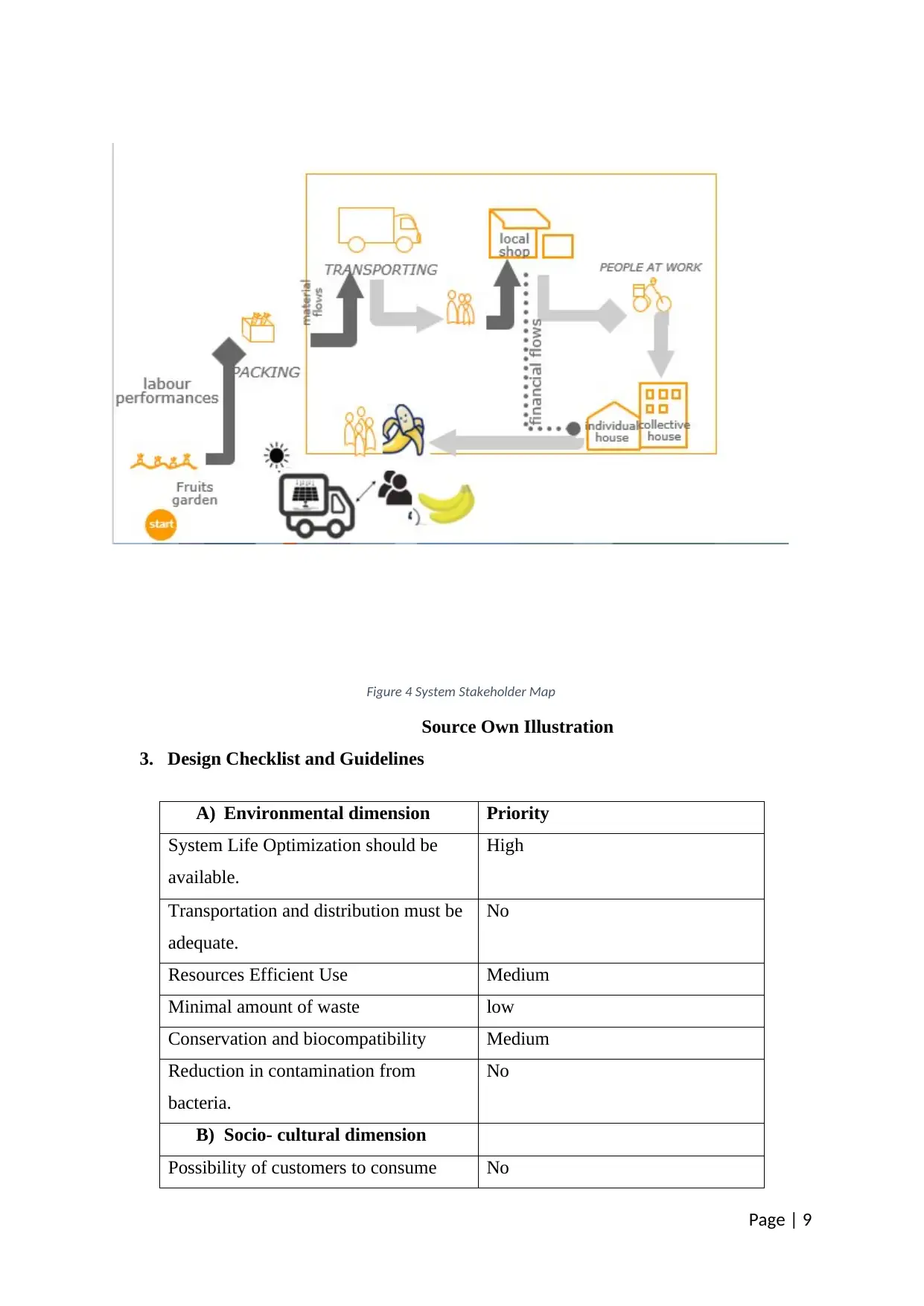
Figure 4 System Stakeholder Map
Source Own Illustration
3. Design Checklist and Guidelines
A) Environmental dimension Priority
System Life Optimization should be
available.
High
Transportation and distribution must be
adequate.
No
Resources Efficient Use Medium
Minimal amount of waste low
Conservation and biocompatibility Medium
Reduction in contamination from
bacteria.
No
B) Socio- cultural dimension
Possibility of customers to consume No
Page | 9
Source Own Illustration
3. Design Checklist and Guidelines
A) Environmental dimension Priority
System Life Optimization should be
available.
High
Transportation and distribution must be
adequate.
No
Resources Efficient Use Medium
Minimal amount of waste low
Conservation and biocompatibility Medium
Reduction in contamination from
bacteria.
No
B) Socio- cultural dimension
Possibility of customers to consume No
Page | 9
⊘ This is a preview!⊘
Do you want full access?
Subscribe today to unlock all pages.

Trusted by 1+ million students worldwide
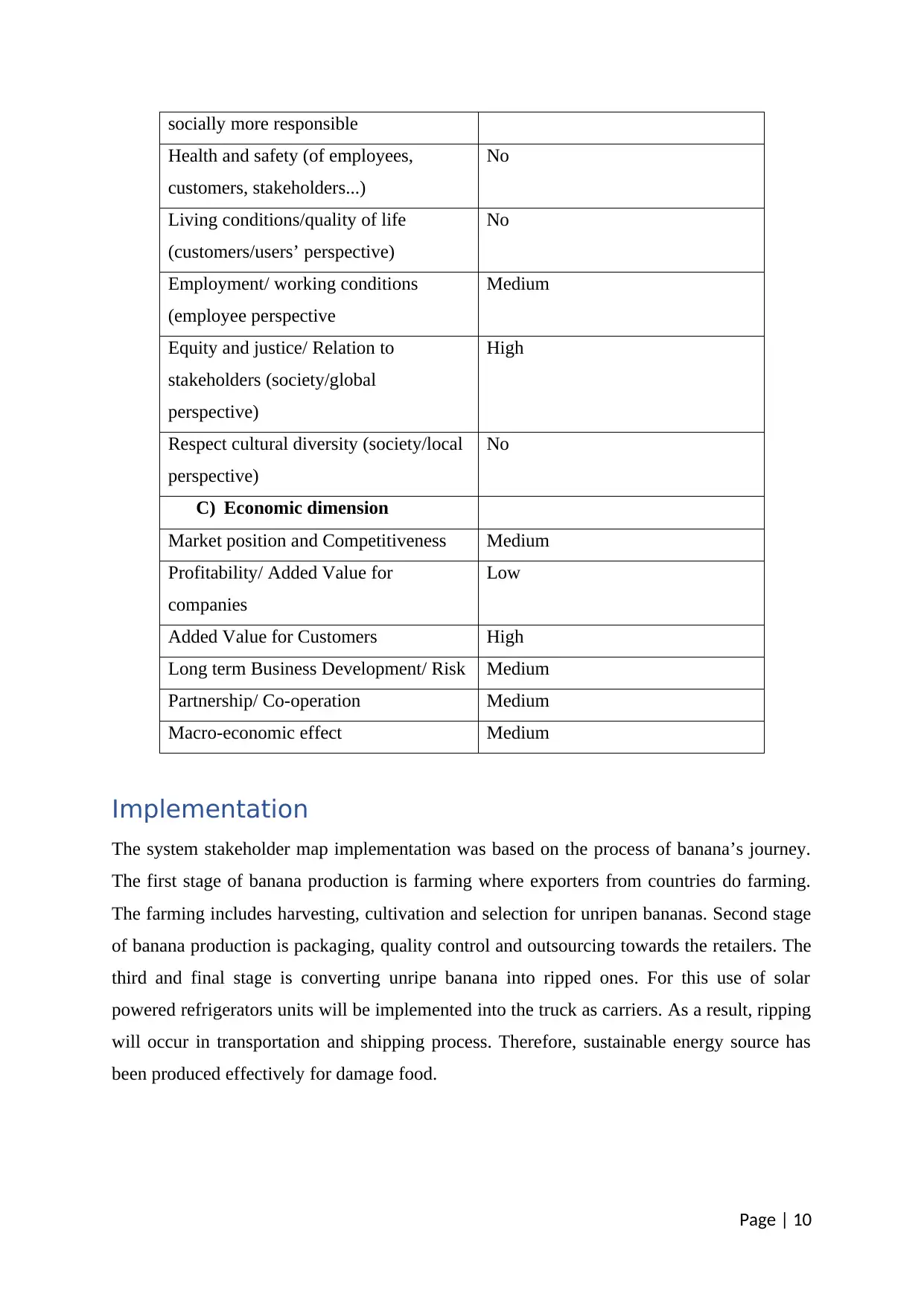
socially more responsible
Health and safety (of employees,
customers, stakeholders...)
No
Living conditions/quality of life
(customers/users’ perspective)
No
Employment/ working conditions
(employee perspective
Medium
Equity and justice/ Relation to
stakeholders (society/global
perspective)
High
Respect cultural diversity (society/local
perspective)
No
C) Economic dimension
Market position and Competitiveness Medium
Profitability/ Added Value for
companies
Low
Added Value for Customers High
Long term Business Development/ Risk Medium
Partnership/ Co-operation Medium
Macro-economic effect Medium
Implementation
The system stakeholder map implementation was based on the process of banana’s journey.
The first stage of banana production is farming where exporters from countries do farming.
The farming includes harvesting, cultivation and selection for unripen bananas. Second stage
of banana production is packaging, quality control and outsourcing towards the retailers. The
third and final stage is converting unripe banana into ripped ones. For this use of solar
powered refrigerators units will be implemented into the truck as carriers. As a result, ripping
will occur in transportation and shipping process. Therefore, sustainable energy source has
been produced effectively for damage food.
Page | 10
Health and safety (of employees,
customers, stakeholders...)
No
Living conditions/quality of life
(customers/users’ perspective)
No
Employment/ working conditions
(employee perspective
Medium
Equity and justice/ Relation to
stakeholders (society/global
perspective)
High
Respect cultural diversity (society/local
perspective)
No
C) Economic dimension
Market position and Competitiveness Medium
Profitability/ Added Value for
companies
Low
Added Value for Customers High
Long term Business Development/ Risk Medium
Partnership/ Co-operation Medium
Macro-economic effect Medium
Implementation
The system stakeholder map implementation was based on the process of banana’s journey.
The first stage of banana production is farming where exporters from countries do farming.
The farming includes harvesting, cultivation and selection for unripen bananas. Second stage
of banana production is packaging, quality control and outsourcing towards the retailers. The
third and final stage is converting unripe banana into ripped ones. For this use of solar
powered refrigerators units will be implemented into the truck as carriers. As a result, ripping
will occur in transportation and shipping process. Therefore, sustainable energy source has
been produced effectively for damage food.
Page | 10
Paraphrase This Document
Need a fresh take? Get an instant paraphrase of this document with our AI Paraphraser
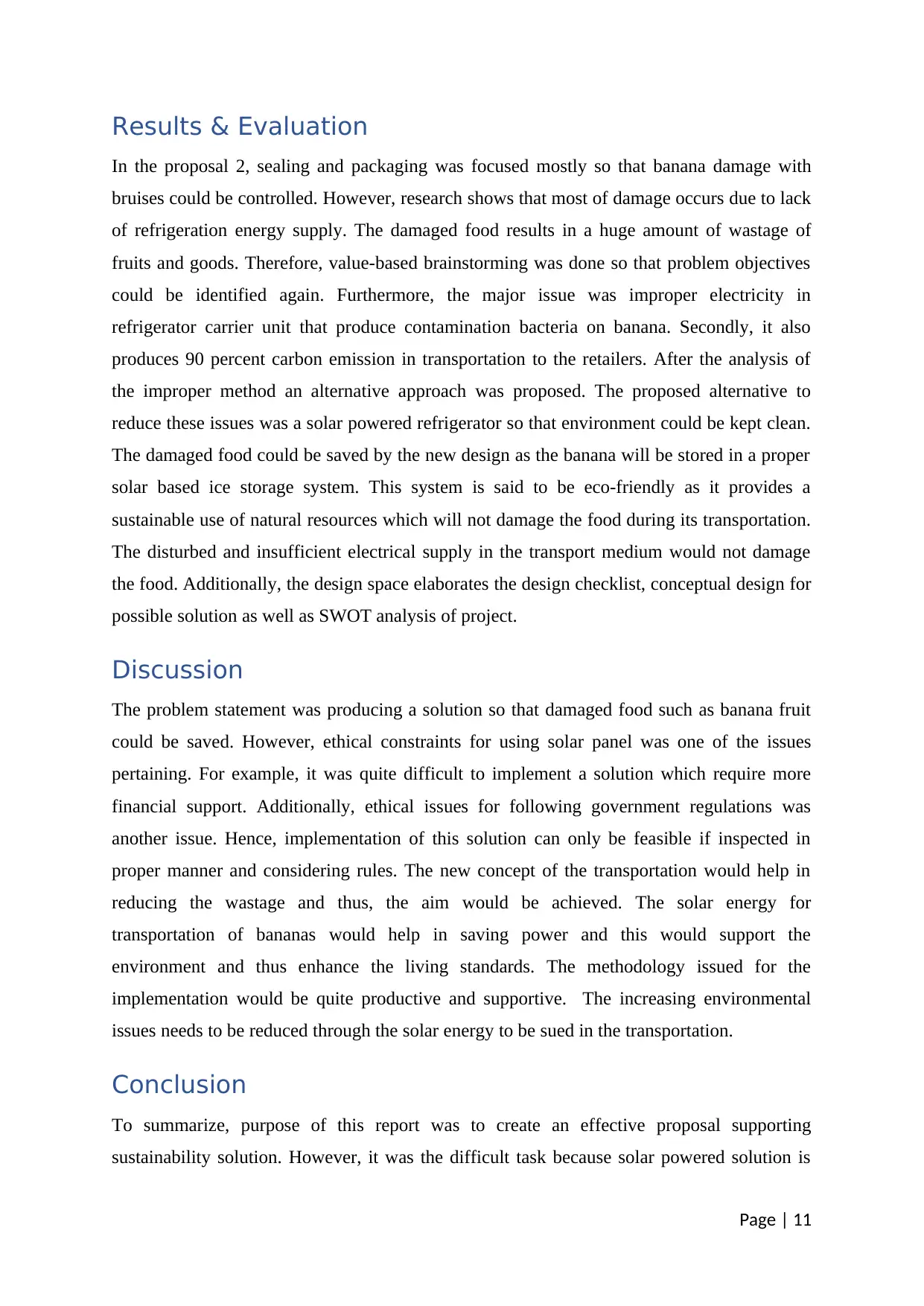
Results & Evaluation
In the proposal 2, sealing and packaging was focused mostly so that banana damage with
bruises could be controlled. However, research shows that most of damage occurs due to lack
of refrigeration energy supply. The damaged food results in a huge amount of wastage of
fruits and goods. Therefore, value-based brainstorming was done so that problem objectives
could be identified again. Furthermore, the major issue was improper electricity in
refrigerator carrier unit that produce contamination bacteria on banana. Secondly, it also
produces 90 percent carbon emission in transportation to the retailers. After the analysis of
the improper method an alternative approach was proposed. The proposed alternative to
reduce these issues was a solar powered refrigerator so that environment could be kept clean.
The damaged food could be saved by the new design as the banana will be stored in a proper
solar based ice storage system. This system is said to be eco-friendly as it provides a
sustainable use of natural resources which will not damage the food during its transportation.
The disturbed and insufficient electrical supply in the transport medium would not damage
the food. Additionally, the design space elaborates the design checklist, conceptual design for
possible solution as well as SWOT analysis of project.
Discussion
The problem statement was producing a solution so that damaged food such as banana fruit
could be saved. However, ethical constraints for using solar panel was one of the issues
pertaining. For example, it was quite difficult to implement a solution which require more
financial support. Additionally, ethical issues for following government regulations was
another issue. Hence, implementation of this solution can only be feasible if inspected in
proper manner and considering rules. The new concept of the transportation would help in
reducing the wastage and thus, the aim would be achieved. The solar energy for
transportation of bananas would help in saving power and this would support the
environment and thus enhance the living standards. The methodology issued for the
implementation would be quite productive and supportive. The increasing environmental
issues needs to be reduced through the solar energy to be sued in the transportation.
Conclusion
To summarize, purpose of this report was to create an effective proposal supporting
sustainability solution. However, it was the difficult task because solar powered solution is
Page | 11
In the proposal 2, sealing and packaging was focused mostly so that banana damage with
bruises could be controlled. However, research shows that most of damage occurs due to lack
of refrigeration energy supply. The damaged food results in a huge amount of wastage of
fruits and goods. Therefore, value-based brainstorming was done so that problem objectives
could be identified again. Furthermore, the major issue was improper electricity in
refrigerator carrier unit that produce contamination bacteria on banana. Secondly, it also
produces 90 percent carbon emission in transportation to the retailers. After the analysis of
the improper method an alternative approach was proposed. The proposed alternative to
reduce these issues was a solar powered refrigerator so that environment could be kept clean.
The damaged food could be saved by the new design as the banana will be stored in a proper
solar based ice storage system. This system is said to be eco-friendly as it provides a
sustainable use of natural resources which will not damage the food during its transportation.
The disturbed and insufficient electrical supply in the transport medium would not damage
the food. Additionally, the design space elaborates the design checklist, conceptual design for
possible solution as well as SWOT analysis of project.
Discussion
The problem statement was producing a solution so that damaged food such as banana fruit
could be saved. However, ethical constraints for using solar panel was one of the issues
pertaining. For example, it was quite difficult to implement a solution which require more
financial support. Additionally, ethical issues for following government regulations was
another issue. Hence, implementation of this solution can only be feasible if inspected in
proper manner and considering rules. The new concept of the transportation would help in
reducing the wastage and thus, the aim would be achieved. The solar energy for
transportation of bananas would help in saving power and this would support the
environment and thus enhance the living standards. The methodology issued for the
implementation would be quite productive and supportive. The increasing environmental
issues needs to be reduced through the solar energy to be sued in the transportation.
Conclusion
To summarize, purpose of this report was to create an effective proposal supporting
sustainability solution. However, it was the difficult task because solar powered solution is
Page | 11
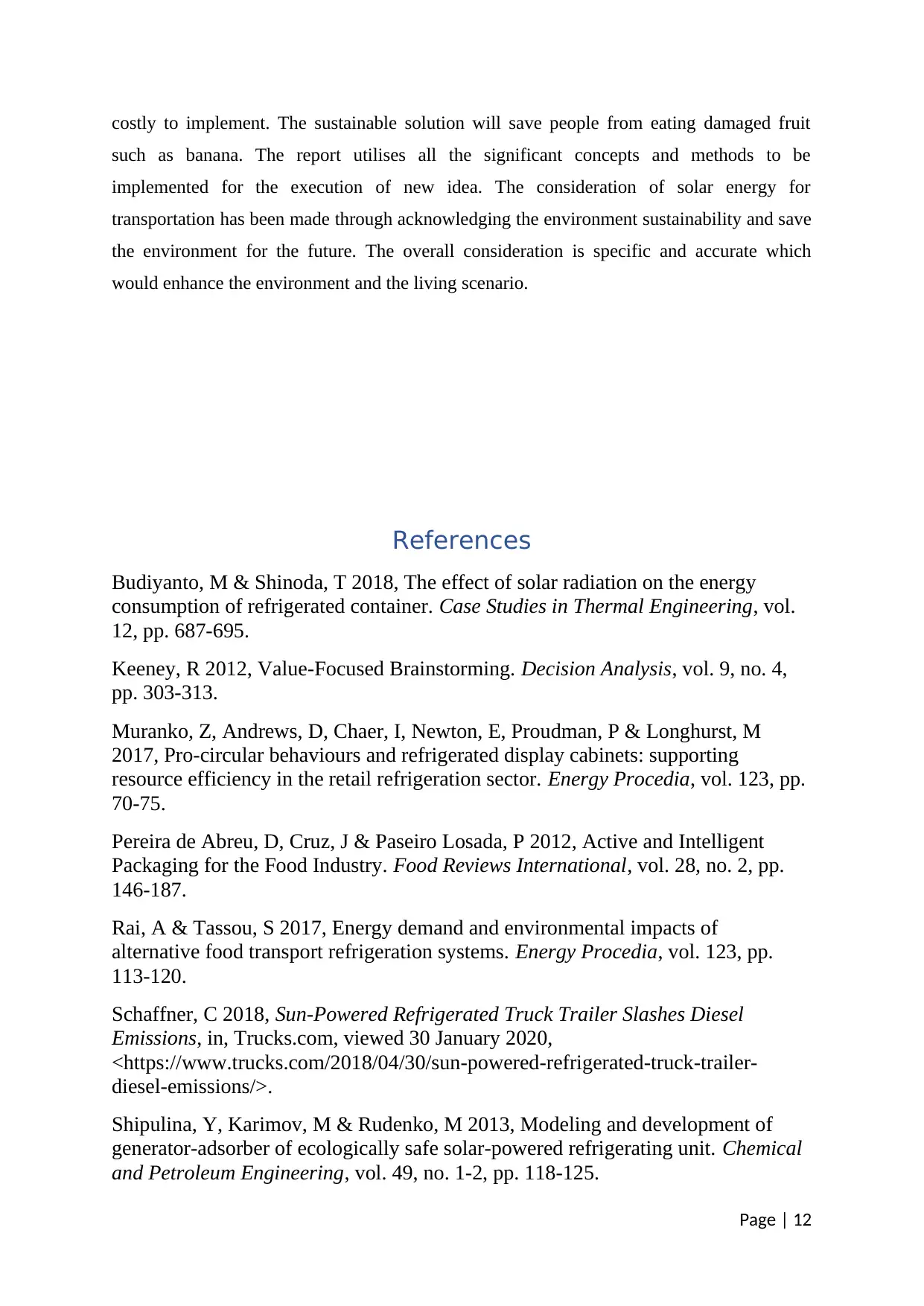
costly to implement. The sustainable solution will save people from eating damaged fruit
such as banana. The report utilises all the significant concepts and methods to be
implemented for the execution of new idea. The consideration of solar energy for
transportation has been made through acknowledging the environment sustainability and save
the environment for the future. The overall consideration is specific and accurate which
would enhance the environment and the living scenario.
References
Budiyanto, M & Shinoda, T 2018, The effect of solar radiation on the energy
consumption of refrigerated container. Case Studies in Thermal Engineering, vol.
12, pp. 687-695.
Keeney, R 2012, Value-Focused Brainstorming. Decision Analysis, vol. 9, no. 4,
pp. 303-313.
Muranko, Z, Andrews, D, Chaer, I, Newton, E, Proudman, P & Longhurst, M
2017, Pro-circular behaviours and refrigerated display cabinets: supporting
resource efficiency in the retail refrigeration sector. Energy Procedia, vol. 123, pp.
70-75.
Pereira de Abreu, D, Cruz, J & Paseiro Losada, P 2012, Active and Intelligent
Packaging for the Food Industry. Food Reviews International, vol. 28, no. 2, pp.
146-187.
Rai, A & Tassou, S 2017, Energy demand and environmental impacts of
alternative food transport refrigeration systems. Energy Procedia, vol. 123, pp.
113-120.
Schaffner, C 2018, Sun-Powered Refrigerated Truck Trailer Slashes Diesel
Emissions, in, Trucks.com, viewed 30 January 2020,
<https://www.trucks.com/2018/04/30/sun-powered-refrigerated-truck-trailer-
diesel-emissions/>.
Shipulina, Y, Karimov, M & Rudenko, M 2013, Modeling and development of
generator-adsorber of ecologically safe solar-powered refrigerating unit. Chemical
and Petroleum Engineering, vol. 49, no. 1-2, pp. 118-125.
Page | 12
such as banana. The report utilises all the significant concepts and methods to be
implemented for the execution of new idea. The consideration of solar energy for
transportation has been made through acknowledging the environment sustainability and save
the environment for the future. The overall consideration is specific and accurate which
would enhance the environment and the living scenario.
References
Budiyanto, M & Shinoda, T 2018, The effect of solar radiation on the energy
consumption of refrigerated container. Case Studies in Thermal Engineering, vol.
12, pp. 687-695.
Keeney, R 2012, Value-Focused Brainstorming. Decision Analysis, vol. 9, no. 4,
pp. 303-313.
Muranko, Z, Andrews, D, Chaer, I, Newton, E, Proudman, P & Longhurst, M
2017, Pro-circular behaviours and refrigerated display cabinets: supporting
resource efficiency in the retail refrigeration sector. Energy Procedia, vol. 123, pp.
70-75.
Pereira de Abreu, D, Cruz, J & Paseiro Losada, P 2012, Active and Intelligent
Packaging for the Food Industry. Food Reviews International, vol. 28, no. 2, pp.
146-187.
Rai, A & Tassou, S 2017, Energy demand and environmental impacts of
alternative food transport refrigeration systems. Energy Procedia, vol. 123, pp.
113-120.
Schaffner, C 2018, Sun-Powered Refrigerated Truck Trailer Slashes Diesel
Emissions, in, Trucks.com, viewed 30 January 2020,
<https://www.trucks.com/2018/04/30/sun-powered-refrigerated-truck-trailer-
diesel-emissions/>.
Shipulina, Y, Karimov, M & Rudenko, M 2013, Modeling and development of
generator-adsorber of ecologically safe solar-powered refrigerating unit. Chemical
and Petroleum Engineering, vol. 49, no. 1-2, pp. 118-125.
Page | 12
⊘ This is a preview!⊘
Do you want full access?
Subscribe today to unlock all pages.

Trusted by 1+ million students worldwide
1 out of 16
Related Documents
Your All-in-One AI-Powered Toolkit for Academic Success.
+13062052269
info@desklib.com
Available 24*7 on WhatsApp / Email
![[object Object]](/_next/static/media/star-bottom.7253800d.svg)
Unlock your academic potential
Copyright © 2020–2025 A2Z Services. All Rights Reserved. Developed and managed by ZUCOL.

